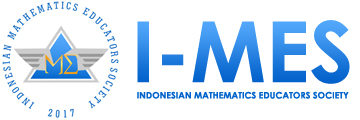The Enhancement of Students Mathematical Communication Ability Through RME-Textbook
DOI:
https://doi.org/10.35706/sjme.v5i1.4412Abstrak
This study was a research and development used ADDIE model aimed to produce mathematics textbook for 8th-grade students by applying five principles of the Realistic Mathematics Education (RME) approach, included: phenomenological exploration, bridging by vertical instruments, self-reliance with students own constructions and productions, interactivity, and intertwining. The subject in this study involved 30 students' junior high school in Yogyakarta. The qualities of the developed textbook refer to three criteria, namely validity, practicality, and effectiveness. Supporting instruments used to examine three criteria for the quality of the textbook were validation sheets, assessment sheets for teachers and students, and students' mathematical communication ability test. The textbook meets the criteria of validity, practicality, and effectiveness if at least "good" from the results of validator assessments, the results analysis from teachers and student assessments, and at least 75% of the students' mathematical communication ability test results. Based on the results of this study, the developed textbook has met the criteria of validity (very good), practicality (very good by the teacher and good by students), and effectiveness (good for 86.67%). Therefore, developing textbooks is suitable to use as an alternative to enhance the students' mathematical communication ability.
Unduhan
Referensi
Anggraini, R. S., & Fuzan, A. (2018). The Influence of Realistic Mathematics Education (RME) Approach on Students’ Mathematical Communication Ability. 285, 208–210.
Asmida. (2011). Meningkatkan kemampuan penalaran dan komunikasi matematis siswa sekolah menengah pertama melalui pendekatan realistik. Tesis Magister, tidak diterbitkan. Universitas Pendidikan Indonesia, Bandung.
Branch, R. M. (2009). Instructional Design: The ADDIE Approach. New York: Springer Science+Business Media, LLC.
Depdiknas. (2008). Panduan Pengembangan Bahan Ajar. Jakarta.
Gravemeijer, K. (2010). Realistic Mathematics Education Theory as a Guideline for Problem-Centered, Interactive Mathematics Education. In R. K. Sembiring, K. Hoogland, & M. Dolk (Eds.), A Decade of PMRI in Indonesia (pp. 41–50). Bandung.
Habsah, F. (2017). Developing teaching material based on realistic mathematics andoriented to the mathematical reasoning and mathematical communication. Jurnal Riset Pendidikan Matematika, 4(1), 43.
Johar, R. (2010). Pendekatan Matematika Realistik Indonesia (PMRI) dan Relevansinya dengan KTSP. Seminar Matematika Universitas Serambi Mekkah 7 Jaunari 2010, pp. 1–8. Aceh.
Lestari, K. E., & Yudhanegara, M. R. (2017). Penelitian Pendidikan Matematika. Bandung: PT Refika Aditama.
Lomibao, L. S., Luna, C. A., & Namoco, R. A. (2016). The influence of mathematical communication on students’ mathematics performance and anxiety. American Journal of Educational Research, 4(5), 378–382.
Nicol, C. C., & Crespo, S. M. (2006). Learning to Teach with Mathematics Textbooks: How Preservice Teachers Interpret and Use Curriculum Materials. Educational Studies in Mathematics, 62, 331–355.
Nieveen, N. (1999). Prototyping to Reach Product Quality. In J. van den Akker, R. M. Branch, K. Gustafson, N. Nieveen, & T. Plomp (Eds.), Design Approaches and Tools in Education and Training (pp. 125–136). Dordrecht: Springer-Science+Business Media, B.V.
NTCM. (2000). Principle and Standards for School Mathematics. Reston: NTCM, Inc.
OECD. (2016). PISA 2015 Results in Focus. Retrieved from www.oecd.org/pisa.
Republik Indonesia. (2007). Undang-Undang Republik Indonesia Nomor 16 Tahun 2007 tentang Standar Kualifikasi Akademik dan Kompetensi Guru.
Republik Indonesia. (2016). Undang-Undang Republik Indonesia Nomor 21 Tahun 2016 tentang Standar Isi Pendidikan Dasar dan Menengah.
Reys, B. J., Reys, R. E., & Chavez, O. (2004). Why Mathematics Textbook Matter. Educational Leadership, 61–66.
Treffers, A. (1987). Three Dimensions: A Model of Goal and Theory Description in Mathematics Instruction – The Wiskobas Project. Dordrecht: D. Reidel Publishing Company.
Trisnawati, T., Pratiwi, R., & Waziana, W. (2018). The effect of realistic mathematics education on student’s mathematical communication ability. Malikussaleh Journal of Mathematics Learning (MJML), 1(1), 31.
Vale, I., & Barbosa, A. (2017). The Importance of Seeing in Mathematics Communication. Journal of the European Teacher Education Network, 12, 49–63.
Van de Walle, J. A., Karp, K. S., & Bay-Williams, J. M. (2013). Elementary and Middle School Mathematics: Teaching Developmentally (8th Ed). Boston: Pearson.
Widoyoko, E. P. (2017). Evaluasi program pembelajaran panduan praktis bagi pendidik dan calon pendidik. Yogyakarta: Pustaka Pelajar.
Wijaya, A., van den Heuvel-Panhuizen, M., & Doorman, M. (2015). Opportunity-to-learn context-based tasks provided by mathematics textbooks. Educational Studies in Mathematics, 89(1), 41–65.
Yang, D.-C., Tseng, Y.-K., & Wang, T.-L. (2017). A comparison of geometry problems in middle-grade mathematics textbooks from Taiwan, Singapore, Finland, and the United States. Eurasia Journal of Mathematics, Science and Technology Education, 13(7), 2841–2857.
Zaini, A., & Marsigit. (2014). Perbandingan Keefektifan Pembelajaran Matematika dengan Pendekatan Matematika Realistik dan Konvensional ditinjau dari Kemampuan Penalaran dan Komunikasi Matematik Siswa. Jurnal Riset Pendidikan Matematika, 1(2), 152–163.
##submission.downloads##
Diterbitkan
Versi
- 2021-03-19 (2)
- 2021-01-29 (1)
Cara Mengutip
Terbitan
Bagian
Lisensi

Artikel ini berlisensiCreative Commons Attribution-ShareAlike 4.0 International License.
Hak cipta dilindingi undang-undang berdasarkan Undang-undang Nomor 28 Tahun 2014 tentang Hak Cipta. Dilarang memperbanyak isi jurnal ini, baik sebagian maupun seluruhnya dalam bentuk apapun tanpa izin tertulis dari SJME (Supremum Journal of Mathematics Education) sebagai pemegang Hak Cipta terhadap seluruh isi dari jurnal tersebut.
Penulis yang menerbitkan jurnal ini setuju dengan persyaratan berikut:
- Penulis mempertahankan hak cipta dan memberikan hak jurnal tentang publikasi pertama dengan karya yang secara bersamaan dilisensikan di bawah Lisensi Atribusi Creative Commons yang memungkinkan orang lain membagikan karya tersebut dengan pengakuan dari karya penulis dan publikasi awal dalam jurnal ini.
- Penulis dapat memasukkan pengaturan kontrak tambahan yang terpisah untuk distribusi non-eksklusif dari versi terbitan jurnal tersebut (misalnya, kirimkan ke repositori institusional atau publikasikan dalam sebuah buku), dengan sebuah pengakuan atas publikasi awalnya di Jurnal ini.
- Penulis diizinkan dan didorong untuk memposting pekerjaan mereka secara online (misalnya di repositori institusional atau di situs web mereka) sebelum dan selama proses penyampaian, karena dapat menyebabkan pertukaran yang produktif, serta kutipan karya yang diterbitkan sebelumnya dan yang lebih lama.











